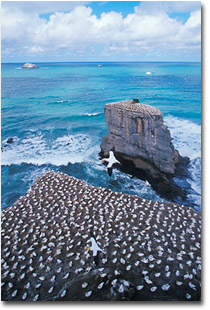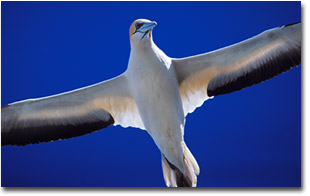Muriwai, on New Zealand’s North Island, is one of those magical places that wildlife photographers dream about. Eighty metres below, a turbulent ocean relentlessly throwing its bulk against the sea cliffs while above the air is alive with movement and sound – Australasian Gannets (Morus Serrato). I knew I’d struck gold the moment I crested the ridge and looked out over the ocean. Before me, literally at my feet, the mainland Gannet colony was boisterously going about its business. Above me, beside me and even below me gannets flew, using the strong sea breeze and the cliff’s updraft to effortlessly glide in a dazzling and hypnotic symphony.
 New Zealand is home to some truly spectacular scenery and Muriwai is no exception. However, very few places on earth can offer such grandeur coupled with convenience. The Muriwai Gannet colony, situated on Auckland’s rugged west coast, is one of only a handful of mainland nesting sites for Australasian Gannets and is accessed by a 200 metre walk from the well sign-posted car park. For the less inclined to ramble among you, this is a godsend.
New Zealand is home to some truly spectacular scenery and Muriwai is no exception. However, very few places on earth can offer such grandeur coupled with convenience. The Muriwai Gannet colony, situated on Auckland’s rugged west coast, is one of only a handful of mainland nesting sites for Australasian Gannets and is accessed by a 200 metre walk from the well sign-posted car park. For the less inclined to ramble among you, this is a godsend.
Muriwai beach is an hour North-West of Auckland. To get there, take the North-Western Motorway and follow Route 16 through Kumeu to Waimauku, and turn left onto Muriwai Road, which runs into Motutara Road. The carpark for the gannet colony is near the bottom of Motutara Road. There’s a small kiosk at the bottom of Motutara Road, but bring some food – after all you’ll not want to miss a moments photography at the colony!
At Muriwai, a 200mm lens is all the length you will need to capture close up frame-filling photos of these noble sea birds. The wind was blowing on shore and this allowed for some great photo opportunities. As the birds came in to land, they would swoop over the viewing area and hover before settling back down into the colony. No easy task when other birds sit beaks to the air, ready to defend their nesting area. After all, the Gannets nest for life and will usually return to the same nest site – so it’s important they protect their claim. But these 2.5kg birds with wingspans of two metres that are so perfectly adapted for flight, so graceful in the air, seem clumsy at making the transition to their unwieldy land legs, often ‘invading’ another pair’s ‘space’ in the nesting area, resulting in a squabbles and pecks for the trespasser.
The colony has two main viewing areas. The best and closest is the northern platform, which overlooks the mainland colony and is just metres from nest sites. This offers the best opportunities for photographs of the birds in flight and at the nests. The southern viewing platform is situated on the adjacent outcrop and gives good views of the mainland colony and the coastline beyond. There’s usually a breeze at Muriwai, but windy condition are superb for catching the Gannets in flight. The best time of day to visit is the morning, when the nest sites are most active.
Two hundred metres off shore the colony has crowded onto every available foot of horizontal land left on the pillar of rock that is Motutara Island. The original colony stands just under one kilometre from the mainland on Oaia Island. Space is, at such, a premium and since the late 1970s the numbers have grown so rapidly that Motutara and Oaia islands can support no more nesting sites and consequently, the colony has expanded to the mainland - the terrestrial dangers associated with that ignored in preference to the space it offers. All tolled there are almost 1000 nesting pairs at Muriwai, and the colony is growing every year.
 The colony is only active between August and March. Towards the end of August the colony is packed with birds and full of noise and activity as the Gannets start their graceful courting rituals. After mating, a single egg is laid, and both birds work in shifts to incubate it. By mid to late November a majority of the colony’s chicks have hatched and are hungry, keeping the parents hunting for food. January sees the chicks’ downy coat begin to shed and chicks can be seen flapping wildly, testing out their wings in preparation for their first flight.
The colony is only active between August and March. Towards the end of August the colony is packed with birds and full of noise and activity as the Gannets start their graceful courting rituals. After mating, a single egg is laid, and both birds work in shifts to incubate it. By mid to late November a majority of the colony’s chicks have hatched and are hungry, keeping the parents hunting for food. January sees the chicks’ downy coat begin to shed and chicks can be seen flapping wildly, testing out their wings in preparation for their first flight.
Photographically, the area is rich in wildlife as there’s more than just Gannets at Muriwai. Bring your binoculars because the water below abounds with activity, from mad-keen surfers braving the conditions to dolphins and fur seals. Other birdlife that you will see at Muriwai will be white-fronted Terns – the original inhabitants of the mainland nesting area, until the Gannet colony spilled over into it, pushing the Terns onto a less desirable hillside nearby.
Any itinerary of New Zealand’s North Island should include a visit to Muriwai. Just don’t forget a good coat, even though it may be bright and sunny the ocean breeze can get chilly after a while. Kiwis have a lot for the rest of us to be envious about and Muriwai is a prime, but little known, example.
Anthony Rodgers - NPN 958
Comments on NPN nature photography articles? Send them to the editor.

